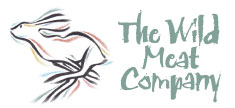20 things you may not know about wild meat
by Robert Gooch October 18 2019
We can hardly believe it’s 20 years since Paul and I launched the Wild Meat Company to share our passion for wild game with the nation. To celebrate our 20th birthday, we’ve compiled our top 20 surprising facts about wild game. How many did you know already?

1. The word “venison” is taken from the Latin venari, meaning “to hunt”. It was originally used to refer to the meat of any wild animal.
2. Eating wild venison could help save Britain’s nightingales and other woodland birds. A British Trust for Ornithology (BTO) study found that the population of our most celebrated songbird has declined by 93 per cent since 1967, with the deer population explosion a major factor. Deer feed on the foliage that nightingales and ground-nesting birds need, leaving them homeless. Higher demand for wild venison would reduce deer numbers and improve the outlook for our threatened species.
3. Wild meat can help you to lose weight. The active, outdoor life of game species makes them much leaner than farmed alternatives.
4. Wild meat, especially venison, is a good source of omega-3 fatty acids, which may help to reduce arthritis symptoms.
5. Prince Charles told Country Life magazine that his favourite dishes included “pheasant crumble” and "groussaka", his own version of the Greek dish moussaka, made with grouse instead of lamb.
6. Wild meat, especially partridge, pheasant and wild rabbit, provides high levels of selenium, a mineral for which 25 per cent of men and 50 per cent of women have been reported to be at risk of a deficiency. Selenium is important for reproduction, thyroid gland function and protecting the body from free radicals and infection.

7. Wild game has a lower carbon footprint than farmed meats. Wild venison, squirrel, wild rabbit and wood pigeon, in particular, have exceptionally low footprints as they are naturally abundant. Many experts agree that eating these wild meats is better for the planet than allowing culled animals to go to waste.
8. Wild venison contains significantly more iron than any meat available in your supermarket. Symptoms of iron deficiency include fatigue and feeling faint or breathless, and reports suggest up to 4 million people in the UK are affected. One serving of our wild venison contains about a third of the recommended daily allowance, making it the ideal red meat to include in a balanced, healthy diet.
9. Wood pigeon is another beef-beating source of iron, delivering a quarter of the recommended daily allowance, while beef provides just a fifth.
10. Game birds are an ideal protein source for body builders, containing much higher levels than farmed poultry. Pheasant, for example, contains 41g of protein per 100g serving compared with 20–30g in chicken or turkey.

11. Game is incredibly versatile and can replace farmed meats in most recipes for a tastier, healthier and more sustainable meal. The most straightforward swaps are wild venison in place of beef or lamb, and rabbit, pheasant or partridge instead of chicken or turkey.
12. Squirrel is our third best-selling product. Often bought for the novelty factor the first time, customers come back for more when they discover how tasty it is. Slow-cooked, it makes an excellent casserole or ragu, as found on Ivan Tisdall-Downes’s menu at Native in London’s Borough Market. We also love it barbecued or deep-fried in breadcrumbs.
13. Wild meat is rich in B vitamins. Partridge, for example, contains more vitamin B6 – which helps the body to form haemoglobin, regulate the metabolism and produce serotonin – than the equivalent amount of chicken, turkey, beef or lamb. Wild venison is another good source of B6 while also containing more than two and a half times as much vitamin B12 than beef per 100g. Vitamin B12 is essential for keeping the body’s nerve and blood cells healthy.
14. Game is an excellent choice for curries, as the deeper flavour of the meat is a great match for spices.

15. Within Europe, Italy is the largest consumer of rabbit meat, with the delicate meat of wild rabbits highly prized.
16. To satisfy our ancestors’ love of strongly favoured meat, game meat used to be hung for weeks. As tastes have changed, our game is hung for between three to seven days for a more delicate flavour.
17. The “gamey” flavour of wild meat is the result of the animal’s natural, varied diet. Farmed animals eat a bland diet based around grass or grain, resulting in bland meat. Wild animals, on the other hand, enjoy a variety of grasses, berries, grains and insects, and this is what makes their meat so flavoursome.
18. Until Queen Victoria took to the throne, wild game would have been the Christmas dinner of choice for many. In medieval Britain, woodcock and wild venison graced the tables of the rich, while the poor ate the offal, known as “umbles”, in an “umble pie”.
19. It’s estimated that between 30 and 50 per cent of British wild game is exported to the continent for our European neighbours to enjoy, while many Brits never even try it.
20. You don’t have to be a great cook to enjoy game. We offer many convenient family-friendly wild meat products that make it easy for everyone to enjoy game any day of the week. These include various wild game sausages and burgers, mini game roasts and marinated fillets that bake in the oven in just five minutes.


